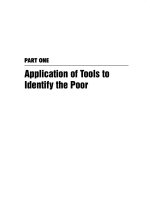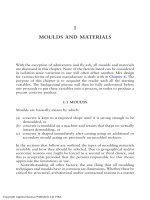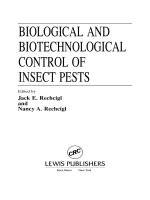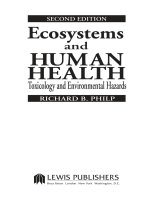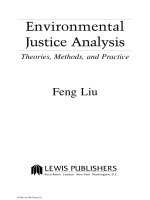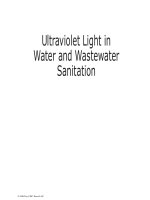Interactions Between Agroecosystems and Rural Communities - Chapter 1 pdf
Bạn đang xem bản rút gọn của tài liệu. Xem và tải ngay bản đầy đủ của tài liệu tại đây (209.61 KB, 17 trang )
Interactions
Between
Agroecosystems
and Rural
Communities
Edited by
Cornelia Flora, Ph.D.
Boca Raton London New York Washington, D.C.
CRC Press
© 2001 by CRC Press LLC
Advances in Agroecology
Series Editor: Clive A. Edwards
Soil Ecology in Sustainable Agricultural Systems,
Lijbert Brussaard and Ronald Ferrera-Cerrato
Biodiversity in Agroecosystems,
Wanda Williams Collins and Calvin O. Qualset
Agroforestry in Sustainable Agricultural Systems,
Louise E. Buck, James P. Lassoie, and Erick C.M. Fernandes
Agroecosystem Sustainability: Developing Practical Strategies,
Stephen R. Gliessman
Structure and Function in Agroecosystem Design and Management,
Masae Shiyomi and Hiroshi Koizumi
Advisory Board
Editor-in-Chief
Clive A. Edwards
The Ohio State University, Columbus, OH
Editorial Board
Miguel Altieri
University of California, Berkeley, CA
Lijbert Brussaard
Agricultural University, Wageningen, The Netherlands
David Coleman
University of Georgia, Athens, GA
D.A. Crossley, Jr.
University of Georgia, Athens, GA
Adel El-Titi
Stuttgart, Germany
Charles A. Francis
University of Nebraska, Lincoln, NE
Stephen R. Gliessman
University of California, Santa Cruz
Thurman Grove
North Carolina State University, Raleigh, NC
Maurizio Paoletti
University of Padova, Padova, Italy
David Pimentel
Cornell University, Ithaca, NY
Masae Shiyomi
Ibaraki University, Mito, Japan
Sir Colin R.W. Spedding
Berkshire, England
Moham K. Wali
The Ohio State University, Columbus, OH
© 2001 by CRC Press LLC
Cover photograph courtesy of André Muelhaupt of Basel, Switzerland.
Library of Congress Cataloging-in-Publication Data
Interactions between agroecosystems and rural communities/edited by Cornelia Flora.
p. cm. — (Advances in agroecology)
Includes bibliographical references and index (p. ).
ISBN 0-8493-0917-4 (alk. paper)
1. Agricultural ecology, 2. Agricultural systems. 3. Rural development. I. Flora,
Cornelia Butler, 1943- II. Series.
S589.7 .I5685 2000
306.3' 49—dc21 00-050723
This book contains information obtained from authentic and highly regarded sources. Reprinted material
is quoted with permission, and sources are indicated. A wide variety of references are listed. Reasonable
efforts have been made to publish reliable data and information, but the author and the publisher cannot
assume responsibility for the validity of all materials or for the consequences of their use.
Neither this book nor any part may be reproduced or transmitted in any form or by any means, electronic
or mechanical, including photocopying, microfilming, and recording, or by any information storage or
retrieval system, without prior permission in writing from the publisher.
All rights reserved. Authorization to photocopy items for internal or personal use, or the personal or
internal use of specific clients, may be granted by CRC Press LLC, provided that $.50 per page
photocopied is paid directly to Copyright Clearance Center, 222 Rosewood Drive. Danvers, MA 01923
USA. The fee code for users of the Transactional Reporting Service is ISBN 0-8493-0917-
4/01/$0.00+$.50. The fee is subject to change without notice. For organizations that have been granted
a photocopy license by the CCC, a separate system of payment has been arranged.
The consent of CRC Press LLC does not extend to copying for general distribution, for promotion, for
creating new works, or for resale. Specific permission must be obtained in writing from CRC Press LLC
for such copying.
Direct all inquiries to CRC Press LLC, 2000 N.W. Corporate Blvd., Boca Raton. Florida 33431, or visit
our Web site at www.crcpress.com
Trademark Notice: Product or corporate names may be trademarks or registered trademarks, and are used
only for identification and explanation, without intent to infringe.
Visit our Web site at www.crcpress.com
© 2001 by CRC Press LLC
No claim to original U.S. Government works
International Standard Book Number 0-8493-0917-4
Library of Congress Card Number 00-050723
Printed in the United Stales of America 2 3 4 5 6 7 8 9 0
Printed on acid-free paper
© 2001 by CRC Press LLC
Preface
The idea for this book began over ten years ago through conversations with Clive
Edwards, editor of an agroecosystems series of books. It was clear to both of us
that the human intersect with the environment is mediated by social forces that are
international, national, and local. But at that point there was little research to
demonstrate the nature of the relationships between human institutions and eco-
systems.
Seven years later, innovative research was underway. Building on the farming
systems tradition of research, which looked at farmers as actors with socio-economic
constraints and values, the importance of communities—of interest and communities
of place—in determining individual actions had become much more widely recog-
nized. It was time to revisit the project. Encouraged by Professor Edwards, I cast
a very wide net to discover who was doing work that would help define these im-
portant interactions. Rather than survey articles, I sought original research from
researchers and practitioners of agroecosystem development and management. Thus
the book contains chapters that combine the disciplines of forestry, economics, plant
breeding, agronomy, anthropology, sociology, geography, soil science, agricultural
education, history, landscape planning, landscape ecology, agricultural engineering,
and human ecology.
The authors have lived and worked in many parts of the globe, which has given
them a great appreciation for the specificity of people and places. Despite that spe-
cificity, a number of important conclusions can be drawn in terms of the impact
of monoculture on people and land and the exploitative nature of an export-only
strategy.
MULTIFUNCTIONALITY
Interactions between agroecosystems and rural human communities change land-
scapes and livelihoods, as John Soluri explains in Chapter 3. These interactions are
highly interactive and in constant flux. Further, the interactions are contested by those
who seek alternative uses of the ecosystem, the labor it supports, and the wealth it
generates. The interactions are, of course, constrained by pre-existing ecosystems
and the cultural constructs of the human communities involved on what is possible
and proper. Thus most of the authors link particular communities to particular places
at particular historical moments.
Communities work best to develop and sustain healthy agroecosystems under
conditions of widespread participation, transparency, and widespread community
benefits. When control of agroecosystems and rural communities is highly concen-
trated, when all decisions are made behind closed doors and there is no clear and reg-
ular accountability, and when only a few profit from what is viewed as a common
© 2001 by CRC Press LLC
legacy, the entire agroecosystem rapidly deteriorates, as Klooster makes clear in
Chapter 5 and Mayda illustrates in Chapter 4. Unequal power, both within rural com-
munities and between rural communities and outside market actors, leads to both
social and environmental deterioration.
The articles demonstrate the applicability of the principles of evolutionary biol-
ogy. As new crops are introduced and have a year or two of success, pests quickly
invade and radically reduce yield. When pesticides are used to overcome these pests,
the pests evolve resistant strains and the land becomes unusable for that crop. Melons
in Mexico (Magdalena Barros Nock in Chapter 6) and bananas in Honduras (John
Soluri in Chapter 3) serve as examples of that type of evolution. Both chapters illus-
trate the impacts on the local ecologies and populations.
When agricultural production is approached as a linear process, identifying a
problem, implementing a counter measure, which natural pests and ecosystems
respond to in ways that create a new problem, a technological treadmill is created.
This is shown in the case of application of nutrients in the chapters by Monsen
(Chapter 12) and by Flora,McIsaac,Gasteyer,and Kroma (Chapter 9). Only a sys-
tems approach, which rethinks the relation sustainability is not the same as stable.
So, too, do institutions evolve to overcome the constraints imposed by policy
aimed to protect the environment and social equity. Klooster (Chapter 5) and Bendini
(Chapter 8) illustrate these principles. Because institutions have purposes other than
survival, they can evolve in ways that enhance the environment and promote social
equity through their positive impact on a agroecosystems as illustrated by Herzog
and Oetmann (Chapter 7), Mountjoy (Chapter 15), Lightfoot, Fernandez, Noble,
Ramírez, Groot, Fernandez-Baca, Shao, Muro, Okelabo, Mugenyi, Bekalo, Rianga,
and Obare (Chapter 10), Rule, Szymanski, and Colletti (Chapter 13), and Flora et al.
(Chapter 9), and Barón and Barkin (Chapter 14).
These institutions can be a part of the market sector, the state sector, or civil soci-
ety. The best combine institutional collaboration among all three sectors, as shown by
Mountjoy and by Rule et al. But institutional institutions that take agroecosystems
into account seem more complicated than technological silver bullets. Our willing-
ness as a society to invest in institutions and systems as well as in specific technolo-
gies will determine the future health of both agroecosystems and rural human
communities.
© 2001 by CRC Press LLC
Acknowledgments
This book would not have been possible without the editorial and formatting assis-
tance of Pam Cooper and the graphics assistance of Kristi Hetland, both of the North
Central Regional Center for Rural Development. Their hard work, dedication,
and
flexibility made this a more enjoyable experience for the authors and editors alike. A
special note of gratitude goes to John Sulzycki, Senior Editor at CRC Press, who
stuck with us through delays and formatting difficulties.
© 2001 by CRC Press LLC
About the Contributors
Maria De Lourdes Barón and David Barkin are, respectively, Professor of Rural
Development at the Universidad Autónoma de Chapingo, Morelia Campus, and
Professor of Economics at the Universidad Autónoma Metropolitana, Xochimilco
Campus, in Mexico.
Isaac Bekalo is with the International Institute for Rural Reconstruction (IIRR),
Nairobi, Kenya.
Monica Bendini, sociologist, is a professor in the Department of Social and Political
Sciences, researcher and coordinator of the Social Agrarian Studies Group, and direc-
tor of the postgraduate program on Sociology of Latin American Agriculture at the
National University of Comahue, Argentina. She has authored publications on peas-
antry in Andean areas and on wage labor in production chains. She has co-edited
an international book on globalization, work, and environment, and research books
on sexual division of agrarian work, rural seasonal migrations, and agro-industrial
changes and flexibility of labor.
Gary Bentrup is a landscape planner at the U.S. Department of Agriculture (USDA)
National Agroforestry Center in Lincoln, Nebraska. With Craig Johnson and Dick
Rol, he co-authored a Natural Resources Conservation Service publication entitled
Conservation Corridor Planning at the Landscape Level: Managing for Wildlife
Habitat (2000).
Lorna Michael Butler holds the Henry A. Wallace Endowed Chair for Sustainable
Agriculture, Iowa State University, and is Professor in the Departments of Sociology
and Anthropology. She conducts research and education on the human dimensions of
sustainable food, agriculture, and community systems, with a particular interest in
rural–urban linkages and sustainable business development. Her work includes par-
ticipatory plant breeding, farming systems research in Africa and the Middle East,
community and international development and urban–peri-urban agriculture. She has
authored The Sondeo: A Rapid Reconnaissance Approach for Situational Assessment
(1995), and is co-author of Focus Groups: A Tool for Understanding Community
Perceptions and Experiences (1995) and Human Diversity, Community, and Viable
Food and Agricultural Systems in Exploring the Role of Diversity in Sustainable
Agriculture, edited by R. Olson, C. A. Francis, and S. Kaffka (1995).
Richard Carkner is a professor and extension economist with Washington State
University (WSU). He recently completed a sabbatical with the FAO in Rome look-
ing at urban agriculture and food security. His current emphasis is on agriculture in
urbanizing counties. He is on the executive committee of WSU’s Food and Farm
Connections team, whose mission is to enhance sustainable community food and
© 2001 by CRC Press LLC
farm systems through education, research, and partnerships. He currently is studying
marketing in the Pacific Northwest.
Joe P. Colletti is Associate Professor of Forestry: Economics and Quantitative Meth-
ods. He has been president of the Association for Temperate Agroforestry (AFTA)
and a co-leader of the Leopold Center for Sustainable Agriculture’s Agroecology
Issue Team since 1992. He has written several articles on the economics of riparian
buffers applied to agricultural landscapes and multipurpose shelterbelts. He was
lead principal investigator of an agroforestry project with the Winnebago Tribe of
Nebraska and learned to “think like a mountain” from his Winnebago friends.
Maria E. Fernandez works on farmer participatory research, focusing on gender
and agrobiodiversity management issues. She has worked for Food and Agriculture
Organization (FAO), Center for Research and Information on Low-External Input
and Sustainable Agriculture (ILEIA), and Centro Internacional de Agricultura
Tropical (CIAT), and is a member of ISG and Grupo Yanapai. She currently is an
independent consultant and visiting professor at the Universidad Nacional Agraria La
Molina in Peru.
Edith Fernández-Baca is a member of Grupo Yanapai, a nongovernmental organi-
zation involved in participatory-action research in the Central Andes of Peru. She also
is a member of the International Support Group (ISG). A Doctor in Veterinary
Medicine, she has been working for the past 7 years with rural communities in nat-
ural resource management and sustainable agriculture. She currently is engaged in
graduate studies in rural sociology at Iowa State University and is working as a
research associate in the North Central Regional Center for Rural Development.
Cornelia Butler Flora is Professor of Sociology and Director of the North Central
Regional Center for Rural Development (NCRCRD), located at Iowa State
University. One of four regional centers in the United States, the NCRCRD combines
research and outreach for rural development and covers the 12 North Central states.
She held the Endowed Chair in Agricultural Systems at the University of Minnesota
from October 1999 to May 2000. Previously, she was head of the Sociology
Department at Virginia Polytechnic Institute and State University, a University
Distinguished Professor at Kansas State University, and a program officer for the
Ford Foundation. A past president of the Rural Sociological Society, she is author and
editor of a number of recent books, including Agroecosystems and Rural
Communities, Rural Communities: Legacy and Change, Rural Policies for the 1990s,
and Sustainable Agriculture in Temperate Zones.
Her current research addresses alternative strategies of community development
and measurement of community change in the United States and Latin America. Her
Bachelor of Arts degree is from the University of California at Berkeley in 1965, and
her M.S. (1966) and Ph.D. (1970) degrees are from Cornell University, where she
received the 1994 Outstanding Alumni Award from the College of Agriculture and
Life Science. She was president of the Board of Directors of the Henry A. Wallace
Institute of Alternative Agriculture, and now serves on the Board of Directors of
Winrock International. She currently is on the Board of Directors of the Heartland
© 2001 by CRC Press LLC
Institute for Community Leadership, the Board on Agriculture and Natural Resources
of the National Research Council of the National Academy of Science, and the
Northwest Area Foundation.
Charles A. Francis is Professor of Agronomy and Extension Cropping Systems
Specialist at University of Nebraska, Lincoln. He is editor or co-editor of Multiple
Cropping Systems, Sustainable Agriculture in Temperate Zones, Exploring the Role of
Diversity in Sustainable Agriculture, and Crop Improvement for Sustainable Agricul-
ture. He is on the editorial boards of three journals, and has written numerous articles
on multiple cropping, sustainable farming systems, on-farm research methods, and
methods for teaching agroecology and integrated crop/animal systems. He currently
is active with colleagues in developing the new Nordic M.Sc. degree in agroecology.
Stephen Gasteyer is a Ph.D. candidate in sociology at Iowa University, focusing on
community development and natural resources management. He has worked in the
United States, Africa, and the Middle East on natural resources, agriculture, and
development issues. He has co-authored articles, chapters, and reports on local indi-
cators of environmental quality, participation in water quality protection, power, and
perceptions of landscape change, integrated pest management, biodiversity, and sus-
tainable agriculture and community development. He currently is working on his dis-
sertation on community organization to protect water quality.
Annemarie Groot is with the International Support Group (ISG), Amersfoort,
Netherlands.
Felix Herzog is a senior researcher at the Swiss Federal Research Station for
Agroecology and Agriculture. He leads a group that evaluates the effect of the Swiss
agri-environmental program on biodiversity and on the quality of ground and surface
water with respect to excess nutrients. He has worked for 15 years in landscape ecol-
ogy and agroecology with experience in West Africa, Germany, and Switzerland. He
has published his work in numerous articles in journals and books.
Daniel James Klooster is Assistant Professor of Geography at Florida State
University in Tallahassee, Florida. His publications address community forestry
through the lenses of common property theory, resistance, development theory, and
the implications for global environmental change. In his current research, he contin-
ues to examine how local institutions of forest management can help to guide a sus-
tainable relationship between people and forests.
Margaret Kroma is an assistant professor in the Department of Education at Cornell
University. She teaches courses in international extension education and adult edu-
cation. Her research focuses on participatory technology development, gender, and
participatory processes for research and extension.
Clive Lightfoot divides his time between chairmanship of the International Support
Group (an international nongovernment organization that provides support to local
groups in learning approaches to ecologically sound agriculture) and teaching in sys-
tems thinking and agroecosystem analysis with the International Center for
Development Oriented Agriculture (ICRA) based in Montpellier, France. He has
© 2001 by CRC Press LLC
authored many publications on agroecosystems analysis and participatory technol-
ogy development over a research career of more than 20 years in tropical agricultural
development.
Chris Mayda is an assistant professor of Geography at Eastern Michigan University.
She is a dedicated technician working on the web and in documentary digital video
on cultural landscape subjects, especially the rural and agricultural world. She pub-
lishes an online cultural geography journal, www.Geographing.com, and continues
her Canadian border studies for future publication while writing her book on the
changing geography of pigs. Really!
Gregory McIsaac is an assistant professor in the Department of Natural Resources
and Environmental Sciences at the University of Illinois, where he teaches courses in
watershed hydrology and ecosystem management. His research addresses various
aspects of land management and water quality.
Wayne Monsen is the program coordinator for the grant, loan, and whole-farm plan-
ning programs for the Energy and Sustainable Agriculture Program at the Minnesota
Department of Agriculture. A former farmer, he brings a broad depth of farming
experience in production systems and agricultural issues. He networks with farmers,
rural communities, agency staff, extension educators, researchers and nonprofit orga-
nizations to adopt sustainable farming practices and systems, implement whole-farm
planning, and encourage citizen leadership.
Daniel C. Mountjoy is Area Resource Conservationist for the USDA—Natural
Resources Conservation Service in Salinas, California. He develops technical and
educational outreach programs for minority farmers along California’s central coast
to assist them with conserving natural resources. His work provides him with the
opportunity to improve communication between farmers and multiple public agen-
cies. He earned a doctorate in human ecology from the University of California Davis
for his studies in conservation adoption by Japanese, Mexican, and Anglo strawberry
farmers.
Anthony Mugenyi is with Development Support Services (DSS), Soroti, Uganda.
Grace Muro is with the Tanzania Food and Nutrition Center (TFNC), Dar es Salaam,
Tanzania.
Reg Noble is with the International Support Group (ISG), Amersfoort, Netherlands.
Magdalena Barros Nock is a Social Anthropologist with a PhD. in Development
Studies from the Institute of Social Studies in the Hague, Netherlands. She has done
research on the fruit and vegetable business, family enterprises, transnational social
networks, and migration.
Lynette Obare is with the Forest Action Network (FAN), Nairobi, Kenya.
Anja Oetmann is an agricultural scientist who has done research on grassland eco-
logic systems, with a special focus on the effect of different ecologic and manage-
ment conditions on morphologic and genetic diversity of populations. Since 1994,
she has been responsible for public information services and political advice in the
© 2001 by CRC Press LLC
field of plant genetic resources for food and agriculture (PGRFA), whose main objec-
tive is the national implementation of the Global Plan of Action on PGRFA that was
adopted at the 4th International Technical Conference on Plant Genetic Resources
(ITCPGR) 1996 in Leipzig, Germany.
Simon Okelabo is with Development Support Servvices (DDS), Soroti, Uganda.
Ricardo Ramirez is Secretary of the International Support Group (ISG), which links
local experience in agroecosystem management. His research includes multistake-
holder coordination for natural resource management, and he is finishing his Ph.D.
through the University of Guelph’s interdisciplinary program on Rural Studies for
Sustainable Communities. His thesis title is “The Human Side of Information and
Communication Technologies for Rural and Remote Community Development.”
Andrew Rianga is with the Kisii Network for Ecological Agricultural Development
(KNEAD), Kisii, Kenya.
Lita C. Rule is Associate Professor of Forestry at Iowa State University. She teaches
courses on forestry economics, policy, and administration. She has worked with nat-
ural resource researchers and other scientists in the United States and countries
abroad such as Mexico, South Africa, the Philippines, and International Center for
Research in Agro-Forestry (ICRAF), on agroforestry and forestry production sys-
tems, and has just started work on a collaborative research and teaching capacity
development program in South Africa. She has authored publications on agroforestry
and forestry production systerms, mostly on the socioeconomic aspects.
Michele M. Schoeneberger is Research Project Leader and Supervisory Soil
Scientist at the USDA Forest Service/National Resource Conservation Service
(FS/NRCS) National Agroforestry Center, part of the Rocky Mountain Research
Station located in Lincoln, Nebraska. Her research interest in long-term productivity
has involved her in projects ranging from forest harvesting impacts to atmospheric
pollutant effects on vegetation, and now has her looking at better ways to design and
integrate tree-based buffer practices into the landscape to better meet landowner and
societal objectives.
Francis Shao is with Food, Agriculture, and Natural Resources Management
Research Consultants (FANRM), Dar es Salaam, Tanzania.
John Soluri is an Assistant Professor of History at Carnegie Mellon University,
where he teaches courses on Latin American and environmental history and policy.
His research on banana production has appeared in the Hispanic American Historical
Review. He currently is writing a book-length manuscript about the ecosocial history
of banana production in Honduras.
Marcella B. Szymanski is Assistant Extension Professor of Forest and Natural
Resource Economics at the University of Kentucky. She has trained with the Praxis
Group, an international training center for participatory development in Canada and has
a broad background that includes natural resource assessment, forest economics, agro-
forestry, and participatory appraisal methods. She has a passion for participatory devel-
opment and has worked closely with native peoples in the United States and Kenya.
© 2001 by CRC Press LLC
Table of Contents
Chapter 1
Introduction
Cornelia Butler Flora
Chapter 2
Shifting Agroecosystems and Communities
Cornelia Butler Flora
Chapter 3
Altered Landscapes and Transformed Livelihoods:Banana Companies,
Panama Disease,and Rural Communities on the North Coast of
Honduras,1880–1950
John Soluri
Chapter 4
Community Culture and the Evolution of Hog Production:Eastern
and Western Oklahoma
Chris Mayda
Chapter 5
Forest Conservation and Degradation in a Subsubsistence Agricultural
System:Community and Forestry in Mexico
Daniel James Klooster
Chapter 6
Community Fruits and Vegetables for Export:The Impact on Two
Mexican Ecosystems and Rural Communities
Magdalena Barros Nock
Chapter 7
Communities of Interest and Agro-Ecosystem Restoration:
Streuobstin Europe
Felix Herzog and Anja Oetmann
Chapter 8
Transhumant Communities and Agroecosystems in Patagonia
Monica Bendini
© 2001 by CRC Press LLC
Chapter 9
Farm–Community Entrepreneurial Partnerships in the Midwest
Cornelia Butler Flora, Gregory McIsaac, Stephen Gasteyer, and Margaret Kroma
Chapter 10
A Learning Approach to Community Agroecosystem Management
Clive Lightfoot,Maria Fernandez,Reg Noble,Ricardo Ramírez,
Annemarie Groot,Edith Fernandez-Baca,Francis Shao,Grace Muro,
Simon Okelabo,Anthony Mugenyi,Isaac Bekalo,Andrew Rianga,and
Lynette Obare
Chapter 11
Bridges to Sustainability:Links between Agriculture,Community
and Ecosystems
Lorna Michael Butler and Richard Carkner
Chapter 12
Rural Community Leadership in the Lake Benton Watershed
Wayne Monsen
Chapter 13
The Winnebago Tribe’s Agroforestry Project:Linking
Indigenous Knowledge,Resource Management Planning,and
Community Development
Lita C. Rule,Marcella B. Szymanski,and Joe P. Colletti
Chapter 14
Innovation in Indigenous Production Systems to Maintain Tradition
Maria de Lourdes Barón and David Barkin
Chapter 15
Ethnicity,Multiple Communities,and the Promotion of Conservation:
Strawberries in California
Daniel C. Mountjoy
Chapter 16
Ecobelts:Reconnecting Agriculture and Communities
Michele M. Schoeneberger,Gary Bentrup,and Charles A. Francis
Chapter 17
Afterword:An Optimistic Future Scenario
Charles A. Francis
© 2001 by CRC Press LLC
Introduction
Cornelia Butler Flora
The agroecosystem concept involves multiple levels of organization: an individual
organism, a population (groups of similar organisms), communities (groups of dif-
ferent organisms), and an ecosystem, which links the abiotic factors of an environ-
ment and the communities of populations and organisms that occur in a specific area
(Gliessman, 1998).
Human communities can be understood in the same way as comprising individ-
uals, a population (a group of similar or related individuals), communities (interac-
tions among individuals and populations for mutual support), and coalitions of
communities that work together or oppose each other on the basis of interests or
values. Like agroecosystems, communities of place and of interest have emergent
qualities that are more than the sum of the parts. The interactions between popula-
tions and communities of interest and of place can enhance or detract from system
sustainability.
Sustainability is an emergent quality of the interactions between communities of
interest and of place that includes a healthy ecosystem, vital economies, and social
equity. The President’s Council on Sustainability refers to these as the “3 E’s” (The
President’s Council on Sustainable Development, 1999).
The chapters in Interactions between Agroecosystems and Rural Communities
all address these three components of sustainability, and they do so from an interdis-
ciplinary perspective. The authors include historians, geographers, sociologists,
anthropologists, agronomists, soil scientists, foresters, and agricultural engineers. All
of the authors are scholars. Many are also practitioners, seeking to bring about sus-
tainable rural communities embedded in healthy agroecosystems.
Chapter 2 lays out a framework for analyzing the systems levels that impact and
are impacted by human action on the land to grow food and fiber. Chapters 3 through
7 describe how specific rural communities have attempted to vary their agroecosys-
tems in response to changing external conditions and internal community dynamics.
John Soluri shows how the entry of a new commodity—bananas—into the world
market led to an economic boom then an agroecosystem bust in rural communities in
Honduras. Decisions made outside the community—that only a certain color, shape,
and size of fruit, the Gros Michel, was a banana, despite the wide variety of species
present in Honduras—increased the monoculture-devastation cycle. Soluri docu-
ments the response of local communities, government authorities, and transnational
corporations to the agroecosystem changes.
Chris Mayda demonstrates the intersection between culture and agroecosystem.
She analyzes two distinct hog-producing communities in Oklahoma, one with a tra-
1
© 2001 by CRC Press LLC
dition of small farm hog production and one in which a large-scale industrial hog
production was introduced. The relation of the two communities to the pork buyers—
transnational corporations in both cases—was quite different, and the impacts on the
local communities in terms of ecosystem health and social and economic well-being
diverged. Mayda convincingly shows that agroecosystems emerge in response to cul-
tural as well as biophysical context.
Daniel Klooster examines how community organizational structure impacts an
agroforestry ecosystem in Mexico. Building on Mayda’s theme of cultural context,
he shows how the Mexican government and community power structures made it dif-
ficult actually to implement sustainable agroforestry programs in mountain commu-
nities. In a situation of corruption and timber poaching, community members outside
the power structure organized to demand transparency, accountability, and equity in
access to forest resources.
Magdalena Barros Nock examines another effort by rural communities in
Mexico to become integrated into international vegetable markets. Despite patient
attempts at organization and market development, the monoculture necessary to meet
the brokers’demands led to pest infestations that made continuing production impos-
sible. Moreover, dependence on a single broker to transport the fruit across the bor-
der further increased the vulnerability of the farmers, despite government investment
in irrigation and community investment in packing sheds. The development of local
production and handling was based on community organizations and structures.
Felix Herzog and Anja Oetmann show the intersection of community culture,
government policy, and agroecosystems in discussing the perseverance of the
streuobst in central Europe. These diverse, dispersed orchards, after being nearly
wiped out by intensive fruit production in the 1950s through the 1970s, gained recog-
nition and support by communities of interest and of place. Policies were put into
place that rewarded the ecosystem services, particularly biodiversity and landscapes,
that the streuobst provide. Furthermore, new markets were developed for the heir-
loom and site-specific fruits and juices they produce.
Monica Bendini analyzes the intersection of nomadic herding communities in the
Patagonian region of Argentina with changing world markets, government programs,
and ecosystem health. Community organization of both indigenous and creole herders
provided basic control over the commons that worked well in times of high demand
and continuous access to land. But a shifting political agenda has gradually excluded
the herders from the most productive pastures and increased the pressure on arid and
high mountain pastures. The community organizational structures are hard pressed to
respond to the agroecosystem changes imposed by policy and overgrazing.
Cornelia Butler Flora, Gregory McIsaac, Stephen Gasteyer, and Margaret Kroma
examine the intersection of market and community in Illinois by looking at entrepre-
neurial partnerships between farms and communities. Their analysis makes it clear that
institutions off the farm must change if practices on the farm can change, and that when
these changes can take place in rural communities, both farm and townspeople benefit.
The remaining chapters offer a look at planned interventions in agroecosystems
to increase sustainability. These chapters have a strong emphasis on process rather
than technology. Community-agroecosystem actions to increase sustainability are
© 2001 by CRC Press LLC
“abnormal”: they generally do not just happen. Specific interventions can bring about
system change in the layered systems to support the various dimensions of sustain-
ability.
An international, interdisciplinary team made up of Clive Lightfoot, Maria
Fernandez, Reg Noble, Ricardo Ramirez, Annemarie Groot, Edith Fernandez-Baca,
Francis Shao, Grace Muro, Simon Okelabo, and Anthony Mugenyi present a synthe-
sis and analysis of their projects in Africa, Asia, and Latin America that addressed
community-based agroecosystems. The process they present involves phases of
involvement and involvement tools built on a vision of the future and assessment of
the resources available for working toward that future, negotiating access to those
resources, implementing them, and reflecting on movement toward the desired future
conditions.
Lorna Michal Butler and Richard Carkner analyze efforts at linking agriculture,
community, and environment in North America. By using the concept of the food-
shed, they demonstrate how different agroecologies can be enhanced through closer
ties between producers and consumers by utilizing organizations in rural communi-
ties. They focus on sustainability connectors linking agroecosystems to communities.
Wayne Monson examines the process of linking farmers, a rural community, and
agroecosystem deterioration in Minnesota. Multiple uses of the agroecosystem, both
crop production and tourism, require new alliances as well as new practices on the
farmers’ field. Facilitated processes for vision and attention to inclusiveness build
social capital between farmers and rural communities that made it possible for all sec-
tors to be involved in positive action for ecosystem health.
Lita C. Rule, Marcella B. Szymanski, and Joe Colletti analyze a process of build-
ing rural community and ecosystem health simultaneously. They describe the devel-
opment of the Winnebago Tribe’s agroforestry project and the processes used to help
the tribal community balance issues of culture, agroecosystem health, and economic
vitality. The tools they use to help determine balance in agroecosystem management
also build community social capital.
Maria de Lourdes Barón and David Barkin examine a process of combining
indigenous knowledge and cutting-edge science to build on community resources for
sustainability. By analyzing resources currently existing in a rural community’s
agroecosystem—hogs and avocados—they introduce a project to grow low-fat hogs
that fit the community cultural structure and emerging market demands.
Daniel C. Mountjoy analyzes strawberry production in the foothills of
California. The agroecosystems in such situations can be very destructive of the envi-
ronment, workers, and communities. By systematically addressing communities of
interest and of place—and particularly by understanding the cultural diversity among
strawberry farmers—technical assistance and community organization can be ori-
ented toward more sustainable agricultural practices.
Michele M. Schoeneberger, Charles Francis, and Gary Bentrup examine an
innovation in community connections: ecobelts, discussing their contributions to
agroecosystems and communities once they are in place. In addition, they demon-
strate that the process of their participatory design can be important, for building
community around a concept of sustainability.
© 2001 by CRC Press LLC
Finally, Charles Francis, describes life in a utopian community with a sustain-
able agroecosystem. He makes the point that agroecosystems are important not only
for rural areas, but are continued into urban zones. Sustainable agroecosystems are
consistent with high technology, although not necessarily high use manufactured
inputs. However, they require that attention be paid to community institutions and
resources to make them happen.
REFERENCES
Gliessman, S. R., Agroecology: Ecological Processes in Sustainable Agriculture, Ann Arbor
Press, Chelsea, Michigan, 1998, 18.
The President’s Council on Sustainable Development, Towards a Sustainable America:
Advancy Prosperity, Opportunity, and a Healthy Environment for the 21st Century,
U.S. Government Printing Office, Washington, DC, 1999. Available: http://www.
whitehouse.gov/PCSD.
© 2001 by CRC Press LLC


